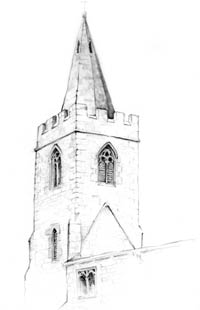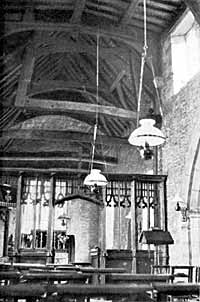Holy Trinity Church, Wysall.
By J. HOLLAND WALKER, M.B.E., F.S.A., F.R.HIST.S.
 Tower of Holy Trinity church, Wysall (A Nicholson,
1979).
Tower of Holy Trinity church, Wysall (A Nicholson,
1979).THE church consists of a tower crowned by a slender and picturesque spire, a nave with south aisle, a south porch and a chancel. The whole building was sympathetically restored in 1873 and again in 1909.
The tower is in the Early English style and may be dated to about the year 1300, and it is surmounted by a singularly graceful spire of the 14th century. This spire rises from within battlements, and in this respect it forms an interesting contrast to the rather earlier broached spire at the neighbouring village of Willoughby. There is a ring of three bells, one of which bears the mark of Henry Oldfield, a member of the family that raised the calling of bell-founding to such eminence in Nottingham. The Oldfield Foundry was in Narrow Marsh and there, in 1610, they cast that well-known bell, “Great Tom” of Lincoln. The bell-chamber is reached by an ancient and very rough ladder which may well be of the 13th century and contemporary with the tower. It is very like the well-known example at West Wittering in Sussex.
The aspect of the interior of the nave is deceptive, for the height of the north wall has something of a pre-Conquest look about it. But this height is not original. The housing of the high-pitched roof still showing on the tower betrays the height of this north wall before it was raised in the 15th century to match the south clerestory.
There is a good deal of rough masonry at the western end of this wall, and Dr. Cox goes so far as to say that it may possibly be of Saxon date. It is well seen from the outside, and there is a curious little window, deeply splayed on the inside and with its head cut from a single stone in the orthodox Saxon manner. But it will be seen that the north door, which is typically Norman in design, is bonded into this walling, and so we must conclude that Dr. Cox has been misled and that this rubble wall was built soon after the Conquest. Probably local masons were employed, and they, working along their ancient tradition, incorporated this Saxon-looking window in their new work.

Wysall. Interior of Holy Trinity Church.
Directly after the Conquest the three manors into which Wysall was divided were granted to Roger de Busli who, in his turn, granted them to one of his followers, also called Roger. This Roger would, no doubt, build a church for his own use at Wysall, and probably this wall is due to him. It will be observed that a pier in the south arcade is, in reality, a piece of ancient wall with a north and south respond. This fragment of wall, being of Norman date, gives us the southern line of Roger's church.
The rest of the north wall is of the 13th century, and there are one or two fragments of ancient glass preserved in the head-lights of a double-lighted Early English window.
Just above the north door is a patch of fresco with the date 1809 faintly discernible. This, and other patches of fresco on this wall show us that in bygone times the interior of the church must have been decorated with a profusion of colour.
The clerestory is of the fifteenth century, and it is significant that whilst there are three windows on the warm south side, there are only two towards the north. The roof is not original, but is an excellent piece of work with good bosses.
The south aisle and porch were rebuilt on old foundations in 1873, but the arcade of three bays, with its chamfer, is of the 14th century. Here and there throughout the church is rustic carving, of no great moment but of considerable interest.
There are a few pre-Reformation benches at the west end, and the delightful 15th-century pulpit has only been restored to use in comparatively modern times. For years it stood neglected, and when redeemed it was found that there were traces of paintings on its panels which it was impossible to preserve.

Wysall. Armstrong Tomb.
The hatchment of George Widmerpool, who died at the age of eighty-four in 1689, is decorative. According to Thoroton, the Widmerpool family held one of the three manors into which Wysall was divided.
The chancel is of the 14th century, and is most interesting. The roof is original and is in an excellent state of preservation. The eastern bay is boarded and would be enriched with colour to form a canopy of honour over the altar.
The screen dates from the 15th century and is remarkably preserved, retaining its original doors. In its lower panels will be observed carefully cut holes which would be used as squints by kneeling worshippers. East of this screen are four misereres with grotesque carving, and at the east of the chancel is an aumbrey and a well-preserved piscina.
The two square-headed Decorated windows in the south wall are of interest, for this square-headed type of window is as characteristic of one phase of Nottinghamshire architecture as is the well-known Kentish tracery characteristic of that of Kent.
The Armstrongs purchased certain rights in Wysall during the reign of Richard III, and the great tomb of Hugh Armstrong, who died in 1572, and his wife Mary, is one of the most conspicuous and beautiful objects in the church. The lady was a Sacheverill, and her arms, impaling those of her husband, may be seen on the shield in the centre of the south side of the tomb.1
1. Arms, Armour and Alabaster, Fellows, p. 34.
